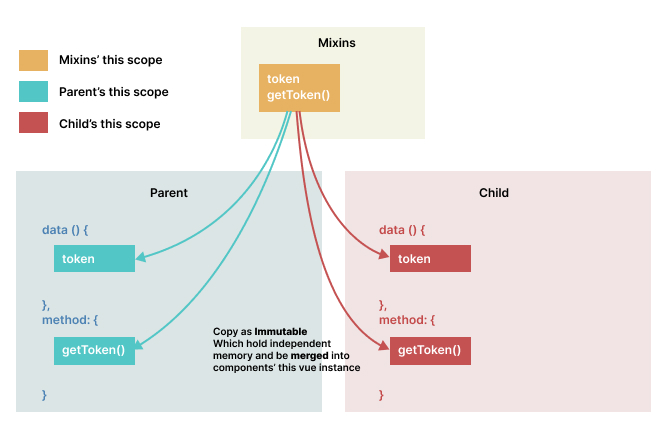Vue Mixins Pitfalls
Vue Mixins Pitfalls
Vue Mixins Pitfalls
...
在工作上第一次接觸到專案開發使用 Vue mixins 到有點氾濫的情況(甚至追朔至2-3個 mixins),所以採到的一個奇妙的雷。
前述一下遭遇的業務邏輯場景:
頁面中存在父子組件同時需要應用一組 Mixins,共有一個 data token 。
由父組件來控制呼叫 API 改變臨時 token 以防用戶誤觸或者有心人士連擊。
子組件則拿更新後的 token 來執行出入金。
mixins 先定義了一個 mixins 提供組件使用。
1 2 3 4 5 6 7 8 9 10 11 12 13 14 15 16 17 18 19 20 21 22 23 24 25 26 27 28 29 30 31 32 import { tokenApi } from '@/api' export default { data ( return { token : '' , } }, mounted ( this .getToken () }, methods : { getToken ( return new Promise ((resolve, reject ) => { tokenApi () .then (resp => if (resp.data .code == 0 ) { this .token = resp.data .data resolve (); } else { reject (); } }) .catch (err => reject (); }) }) }, }, }
Parent component 父組件控制更新 Token 的時機點。
1 2 3 4 5 6 7 8 9 10 11 12 13 14 15 16 17 18 19 20 21 22 23 24 25 26 27 28 29 30 31 32 33 34 35 36 37 ... <template> <component ref ="child" :is ="currentComponent" @submitChild ="submitChild" > </component > </template> <script > import mixin from '@/mixins' ; export default { name : 'parent' , mixins : [mixins], data () { ... } methods : { submitParent ( this .$refs .child .submitChild () .then (resp => if (resp.data .code === 0 ) { ... } else { ... this .getToken () .then (resp => this .loading = false ; }) .catch (resp => this .loading = false ; }) } }) } } } </script >
Child component 子組件因應各自的出入金渠道而需要呼叫不同 API。
1 2 3 4 5 6 7 8 9 10 11 12 13 14 15 16 17 18 19 20 21 22 23 24 25 26 27 28 29 30 31 32 33 <template> ... <el-button :loading="loading" :disabled="loading" @click="submitChild" > submit </el-button> </template> <script > import { childChannelApi } from '@/channels' ; export default { name : 'child' , mixins : [mixins], data () { ... } methods : { submitChild ( return childChannelApi ( { account : '*****' , amount : '1234' , ... }, this .token ) } } } </script >
元件結構示意圖
Merged into component’s own data
Data and methods defined in a mixin are merged into the component’s own data and methods.
參考合併
Each instance of a component using the mixin gets its own independent copy of the data properties defined in the mixin. This means that the top-level properties are not shared between instances , but nested objects and arrays can still share references if not handled properly.
文件與 ChatGpt 有提到合併物件 的概念,這裡要注意的是一旦合併到元件所屬的 data 便意味著參考脫鉤了,無法再元件之間共享同一個位址而是各自為政的狀態,與 Vuex state 不是一個概念,僅能透過 this.$refs.child 的方式取得子元件本身的 scope data,並不符合當前業務邏輯「更新共享 Token」以及「同步共享 Token」的要求了。
問題描述 原先在父組件無論更新幾百次 this.token 都只是更新父祖件本身的 this.token 參考內的值,當子組件呼叫 API 送出的 this.token 永遠不會變化,因為該 token 隸屬於子組件本身的 data,根本是兩個獨立的記憶體位址互相無關。
The token property is a primitive (string). Each component instance (parent and child) gets its own copy of token.
而上述提到的物件與陣列在此情況很可能會共享參考,剛巧不再這次的字串型別(Primative)資料 Issue 中,否則會更難釐清資料來源了。
如此一來父組件的程式需要更改為:
Parent component 1 2 3 4 5 6 7 8 9 10 11 12 13 14 15 16 17 18 19 20 21 22 23 24 25 26 27 28 29 30 31 32 33 34 ... <template> ... </template> <script > import mixin from '@/mixins' ; export default { name : 'parent' , mixins : [mixins], data () { ... } methods : { submitParent ( this .$refs .child .submitChild () .then (resp => if (resp.data .code === 0 ) { ... } else { ... this .$refs .child .getToken () .then (resp => this .loading = false ; }) .catch (resp => this .loading = false ; }) } }) } } } </script >
事後反思 mixins 一開始的應用應該是給予各組件共用可以 extends 出去 的初始狀態,僅是提供「共享邏輯」或者是「共享資料結構」,若要同步更新或共用一份資料很可能比較適合使用 Vuex 或者 LocalStorage、SessionStorage 等方式,以確保物件參考沒有脫鉤,個人認為共享的 functions 或 methods 才比較是 mixins 開發的初衷吧!
有紮實的 Javascript 基礎確實較能抓出框架內的坑,但很多時候坑是開發人員程式設計不慎的後果,例如這次專案中濫用 mixins 就是一個例子,需要提醒自己注意開發的靈敏度與避坑意識 ヽ(・×・´)ゞ

